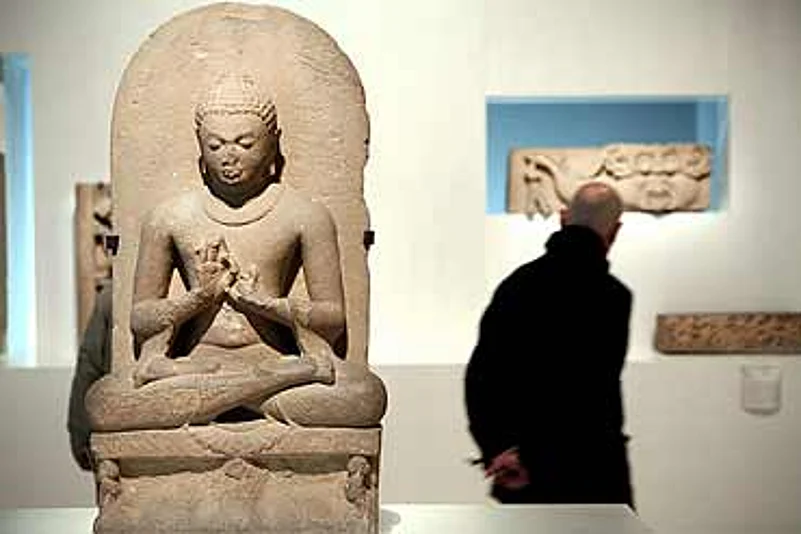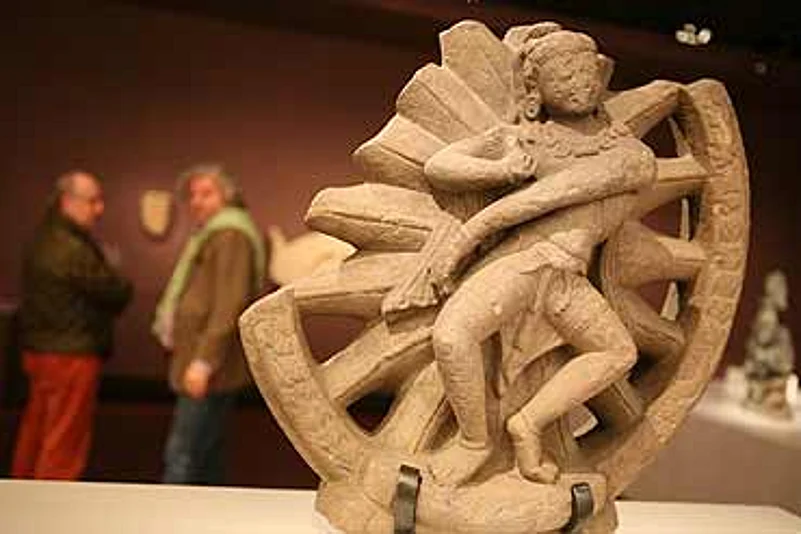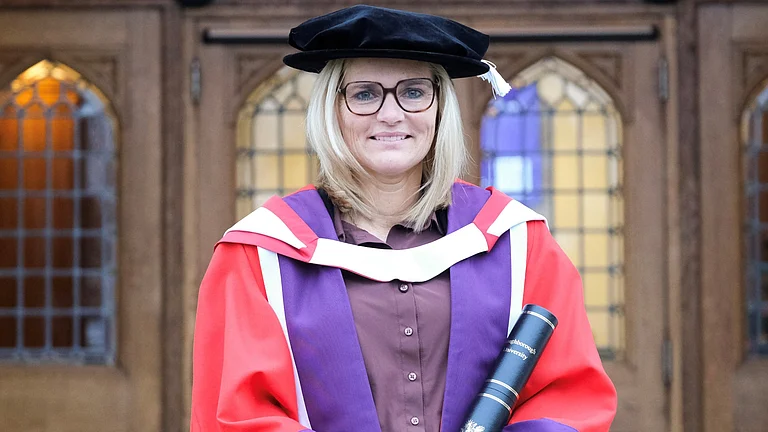
Among the masterpieces now on view at the Grand Palais are the Bodhisattva Avalokiteshwara from Sarnath, whose expression of blissful serenity has been carved out of Chunar sandstone; a rare bifacial image of Shiva and Uma Maheshwari in red-mottled sandstone from Mathura; and a magnificent early 5th-century Vishnu sculpture with Varaha and Narasimha avatars perched on either shoulder. Also on display are gold coins impressed with each Gupta emperor's insignia which, the French newspapers gush, are so dazzling they could well be mistaken for jewellery. One particularly stunning piece is a red sandstone sculpture of Shakyamuni Buddha's torso—through the ripples of his monastic robes, the folds of the antariya, or undergarment, can be glimpsed. This trompe l'oeil impression of transparency is the work of a famed master sculptor of the age named Dinna. Most other works are by unnamed artists.
Sublime as these pieces are, some of the most precious examples of Gupta art remain in India as they belong to the 'AA' category of national treasures, and are forbidden to leave the country. The lustre of the Gupta empire, despite being widely acknowledged to be the golden age of classical India, remains largely unknown internationally. Spanning the whole of northern India from the late 5th century AD to the 7th century, the Gupta empire produced India's most brilliant intellectual luminaries, such as astronomer-mathematicians Varahamihira and Aryabhatta, and poets and dramatists Banabhatta and Kalidasa. This enlightened age is compared to Periclean-era Greece, the zenith of the T'ang dynasty in China, and the Renaissance in Europe.
Though most of the Gupta rulers were themselves Vaishnavite, the religious tolerance they nurtured produced superb Shaivite, Jain and Buddhist art—especially at Mathura and Sarnath. But it is the Buddhist sculpture that attained an unparalleled beauty, influencing art all along the Silk Route. As eminent art historian Stella Kramrisch, describing the Gupta Buddha images, puts it, "No other phase of Indian art approaches its perfection in creating the superhuman features of a state of perfect knowledge."
Dr J.E. Dawson, who was part of the curatorial team, also believes that what makes Gupta sculptures exceptional is their spiritual, meditative quality. "The greatness of the Gupta age can be best summed up by this quote from Kalidasa.... Na rupam papa vritteye, which means 'Beauty, but not for sin'," says Dawson, who heads the archaeology department in the National Museum. "The art of the Kushana period (which preceded the Gupta age) is more naturalistic, voluptuous and sensuous—from breasts to private parts, everything is shown so blatantly. In Gupta art, you don't find this, it is far more spiritual."

a sculpture of a dancing pose
This ethereal sense of serenity gives Gupta-era art a timeless, universal appeal, as Jean-Francois Jarrige, the chief commissioner of the exhibition and director of the Musee Guimet, points out, "The masterpieces of Gupta art are suffused with an ideal of clarity and calmness that places them outside time." It's an appeal that's drawing large crowds to see the exhibition. Says Dr Dawson, who attended the inauguration: "There was no place to walk! The response was overwhelming." Exults Jarrige: "The exhibition has just started, and we're already attracting 2,000 visitors a day."
Rave reviews in the French papers and magazines have helped swell the crowds. As Le Monde's art critic, Emmanuel de Roux, notes, to French people accustomed to exuberant, over-the-top images of India, this exhibition shows the restrained elegance of India's classical age. Or, as another French reviewer puts it, this "exceptional exhibition" affords a rare glimpse into an art that's as precious a part of the Indian identity as the Mona Lisa is to the French.


























